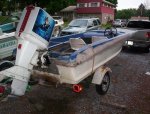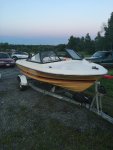Hmmm! I never saw a Bayliner so small rated for such high horsepower. It must be a specialty hull. Are you in USA? Is the hull an 81 year? Is it a "classic" that you do not want to change by adding a tachometer?
At any rate, Here are a couple of things you can do to try to get up around 45 MPH.. #!. You really MUST have a tach. At the very least, if you do not want to drill the dashboard, buy a tiny tach and mount it with double sided tape or Velcro.. 2. Even though relatively short, these engines do perform well with the anti-ventilation plate one inch above the hull bottom, whether it be flat or vee.. 3. They do best with the stock Chrysler props and stainless will deliver about 3 MPH more than stock aluminum. 4. If the engine does have power trim, then after the hole shot, USUALLY they like to run trimmed all the way out--however, hull design can influence that. 5. Be certain that the engine is set correctly. Watch the video on synchronizing carbs and timing. If you will consistently use automobile pump gas you can set timing to 32 degrees BTDC but be aware that 30 is safer. 6. Check the lower unit ratio. These engines will deliver way more speed using a 2 to 1 ratio lower. (turn the flywheel twice with the engine in gear. If the prop turns more than one turn it is a 1.76 ratio.
The engine does like to run at close to its rated RPM range of 5500 RPM. Prop it to achieve as close to 5500 as it can get at WOT.
Of course, check compression and timing to be certain the engine is internally healthy.






















